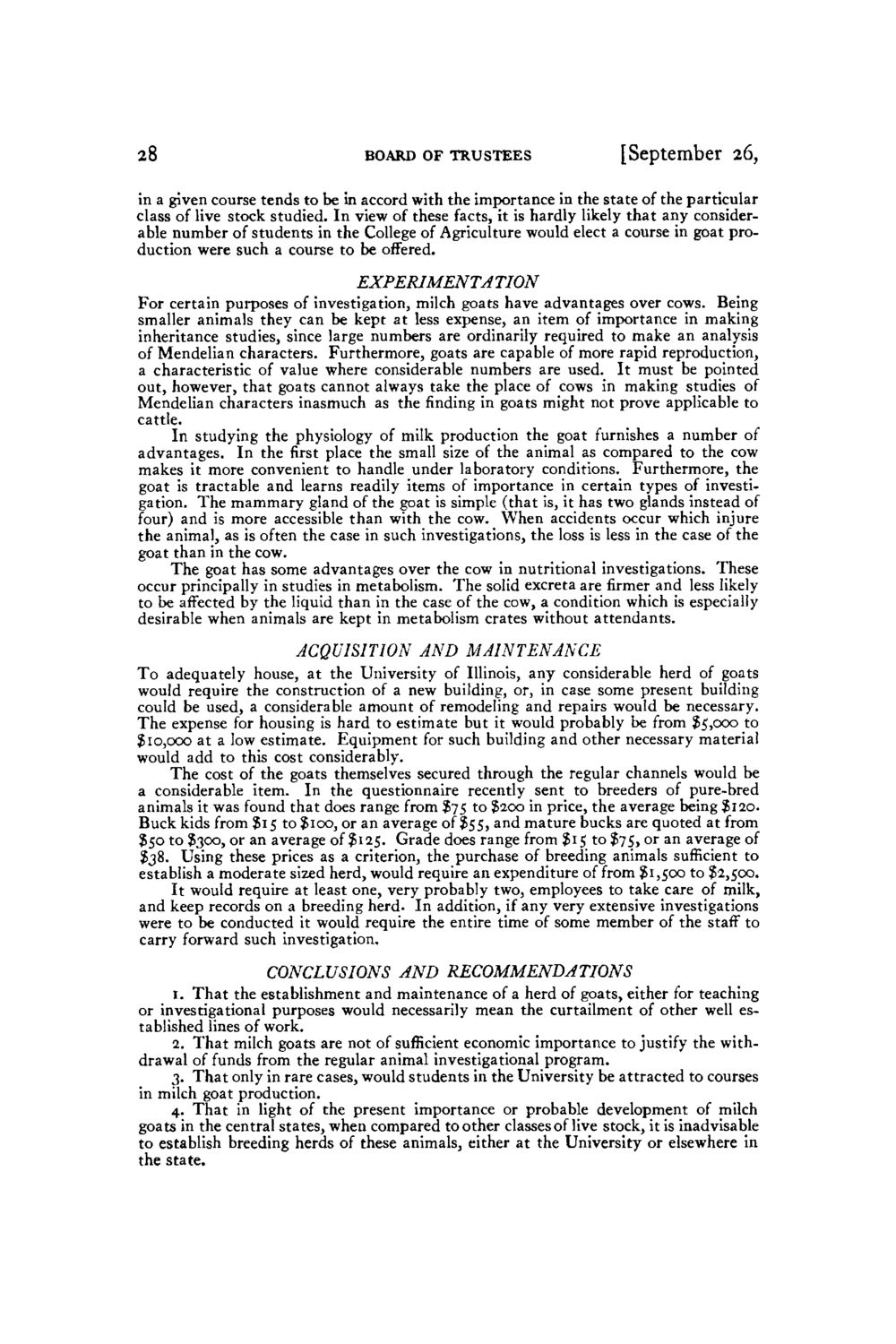| |
| |
Caption: Board of Trustees Minutes - 1926
This is a reduced-resolution page image for fast online browsing.

EXTRACTED TEXT FROM PAGE:
28 board of trustees [September 26, in a given course tends to be in accord with the importance in the state of the particular class of live stock studied. In view of these facts, it is hardly likely that any considerable number of students in the College of Agriculture would elect a course in goat production were such a course to be offered. EXPERIMENTATION For certain purposes of investigation, milch goats have advantages over cows. Being smaller animals they can be kept at less expense, an item of importance in making inheritance studies, since large numbers are ordinarily required to make an analysis of Mendelian characters. Furthermore, goats are capable of more rapid reproduction, a characteristic of value where considerable numbers are used. It must be pointed out, however, that goats cannot always take the place of cows in making studies of Mendelian characters inasmuch as the finding in goats might not prove applicable to cattle. In studying the physiology of milk production the goat furnishes a number of advantages. In the first place the small size of the animal as compared to the cow makes it more convenient to handle under laboratory conditions. Furthermore, the goat is tractable and learns readily items of importance in certain types of investigation. The m a m m a r y gland of the goat is simple (that is, it has two glands instead of four) and is more accessible than with the cow. W h e n accidents occur which injure the animal, as is often the case in such investigations, the loss is less in the case of the goat than in the cow. The goat has some advantages over the cow in nutritional investigations. These occur principally in studies in metabolism. T h e solid excreta are firmer and less likely to be affected by the liquid than in the case of the cow, a condition which is especially desirable when animals are kept in metabolism crates without attendants. ACQUISITION AND MAINTENANCE T o adequately house, at the University of Illinois, any considerable herd of goats would require the construction of a new building, or, in case some present building could be used, a considerable amount of remodeling and repairs would be necessary. T h e expense for housing is hard to estimate but it would probably be from $5,000 to $10,000 at a low estimate. Equipment for such building and other necessary material would add to this cost considerably. The cost of the goats themselves secured through the regular channels would be a considerable item. In the questionnaire recently sent to breeders of pure-bred animals it was found that does range from $75 to $200 in price, the average being $120. Buck kids from $15 to $100, or an average of $55, and mature bucks are quoted at from $50 to $300, or an average of $125. Grade does range from $15 to $75, or an average of $38. Using these prices as a criterion, the purchase of breeding animals sufficient to establish a moderate sized herd, would require an expenditure of from $1,500 to $2,500. It would require at least one, very probably two, employees to take care of milk, and keep records on a breeding herd. In addition, if any very extensive investigations were to be conducted it would require the entire time of some member of the staff to carry forward such investigation. CONCLUSIONS AND RECOMMENDATIONS 1. That the establishment and maintenance of a herd of goats, either for teaching or investigational purposes would necessarily mean the curtailment of other well established lines of work. 2. That milch goats are not of sufficient economic importance to justify the withdrawal of funds from the regular animal investigational program. 3. That only in rare cases, would students in the University be attracted to courses in milch goat production. 4. That in light of the present importance or probable development of milch goats in the central states, when compared toother classesof live stock, it is inadvisable to establish breeding herds of these animals, either at the University or elsewhere in the state.
| |